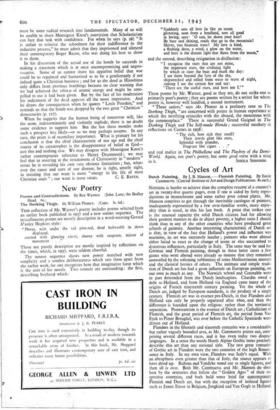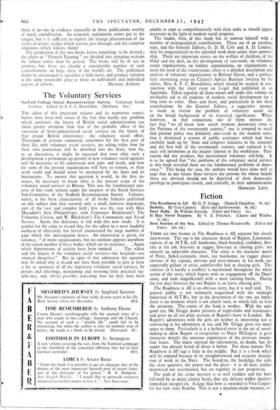Cycles of Art
NOTHING is harder to achieve than the complete resume of a country's art in twenty-five quarto pages, even if one is aided by forty repro- ductions in monochrome and some rather poor colour plates. Mr. Manson contrives to get through the inevitable catalogue of painters, inadequately represented by a few over-familiar works, more enjoy- ably than is usual, in this his last book. A point that strikes one is the unusual capacity the solid Dutch citizens had for allowing their greatest masters to die in abject poverty, a higher ratio I should think than in any of the other countries who have produced great schools of painters. Another interesting characteristic of Dutch art is that, in view of the fact that Holland's power and influence was maritime, its art was extremely insular ; painters who went abroad either failed to react to the change of scene or else succumbed to disastrous influences, particularly in Italy. The same may be said for German and Flemish painting, though in these latter cases a few giants who went abroad were already so mature that they remained unassailed by the softening sublimities of some Mediterranean masters and the classical heroics of others. The intimate and simple tradi- tion of Dutch art has had a great influende on European painting, on our own as much as any. The Norwich school and Constable were in part descended from the Dutch landscapists. Chardin owed a debt to Holland, and from Holland via England came many of the origins of French nineteenth century painting. Yet the whole of Dutch art, judged by European standards, is the product of a single century. Flemish.art was in essence pre-Dutch, in that Flanders and Holland can only be properly separated after 1600, and then the difference is founded upon the religious rather than the territorial separation. Protestantism is the essence of Dutch art ; Catholicism of Flemish, and the great period of Flemish art, the period from Van Eyck to Pieter Breughel, was over before the Catholic Spaniards were driven out of Holland.
Flanders in the fifteenth and sixteenth centuries was a considerable but rather vaguely bounded area, as Mr. Cammaerts points out, com- prising several different races, and it has even today two distinct languages. In a sense the words North Alpine Gothic more precisely describe this art than any national tide. The two great centuries of Gothic art in Flanders were the two centuries of the high Renais- sance in Italy. In my own view, Flanders was Italy's equal. With an abruptness even greater than that of Italy, the source appears to have dried up. Rubens and Vandyke stand out as single" figures, and then all is over. Both Mr. Cammaerts and Mr. Manson do their best by the centuries that follow the Golden Ages " of their re-
spective countries, and both hold some brief for contemporary Flemish and Dutch art, but with the exception of isolated figures such as James Ensor in Belgium, Jongkind and Van Gogh in Holland. there is no one in evidence especially in these publications worthy of much consideration. An economic explanation comes pat to the tongue, but is it sufficient to explain the strange phenomenon of the cycles of artistic vitality which nations pass through, and the complete emptiness which follows them?
The production of the two books leaves something to be desired ; the plates in " Flemish Painting " are divided into irritating sections by subject rather than by period. The books will be of use as primers, but there are already a considerable number of such g.meralisations on large slices of the world's art. The publishers might be encouraged to specialise a little more, and produce volumes at the same reasonable price as these on individuals and individual































 Previous page
Previous page